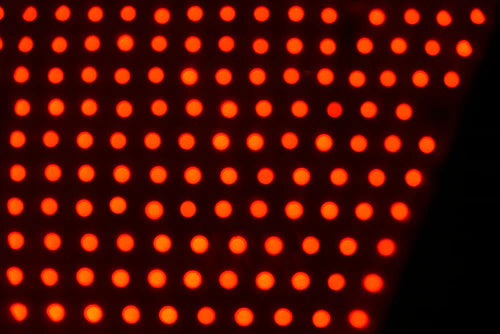Red Light Therapy: Pros, Cons, and Alternatives You Should Know About

Have you heard of red light therapy? It's becoming increasingly popular among health-conscious people but it has pros and cons.
Red light therapy is a non-invasive treatment that uses low levels of red light or near-infrared light to help the body heal itself.
But how safe is this treatment? And what are some alternatives if you're unsure about using red light therapy?
Let's examine the pluses and minuses to decide if this treatment is proper for us.
What is Red Light Therapy?
Red light therapy (RLT) is a phototherapy that uses low-intensity red light waves to hasten recovery and lessen inflammation. Red light therapy has been a natural treatment for hundreds of years, but its possible benefits have become more well-known recently. (1)
Lamps, lasers, or LED panels that send out red light at specific frequencies and intensities can be used to give RLT.
The primary benefit of Red Light Therapy is its ability to stimulate cell regeneration and repair damaged tissue. RLT may also help improve skin health by reducing the appearance of wrinkles, scars, age spots, acne scarring, and sun damage.
In addition to this cosmetic effect on the skin's appearance, it also helps with collagen production, resulting in a firmer skin tone overall. Furthermore, RLT may help reduce pain from chronic conditions such as arthritis or fibromyalgia by decreasing inflammation levels in affected areas while increasing circulation simultaneously.
Red Light Therapy (RLT) works by stimulating chromophores, cells within our bodies that absorb the energy from emitted light waves. (2) This allows for deeper penetration of the therapeutic wavelengths than traditional UV rays could achieve, thereby promoting cellular activity and collagen production throughout various layers beneath our skin's surface.
Additionally, this process can help improve wound healing capabilities depending on where it is applied directly to the affected area, thus reducing inflammation levels while increasing circulation simultaneously - all key elements aiding chronic conditions such as arthritis or fibromyalgia.
Red Light Therapy has demonstrated positive effects on health, from an enhanced skin condition and aesthetics to diminished aches and inflammation. With its many advantages, it is no surprise that Red Light Therapy is becoming increasingly popular amongst the health-conscious population.
Next, we will discuss some of the pros of this treatment.
Key Takeaways
- Red Light Therapy is a popular phototherapy treatment that stimulates cell regeneration, reduces inflammation, and repairs damaged tissue.
- It works by stimulating chromophores in our bodies that absorb the therapeutic wavelengths of light which can help improve skin health while aiding chronic conditions such as arthritis or fibromyalgia.

Safety considerations for red light therapy
Eye protection during treatment is one of red light therapy's most important safety considerations. Red light therapy uses infrared and visible light to penetrate deep into the skin, making it necessary to protect your eyes from any potential damage.
Wearing protective eyewear such as goggles or sunglasses with UV-blocking lenses is recommended when undergoing a red light therapy session. Protective eyewear, like goggles or sunglasses with UV-blocking lenses, can help shield from potential harm caused by intense infrared and visible light during a red light therapy session.
Avoiding sun exposure after treatment is another critical safety consideration for red light therapy. It is essential to stay away from direct sunshine or other UV sources for at least 24 hours after each red light therapy session.
This treatment's infrared and visible lights can make skin more sensitive to ultraviolet radiation. Additionally, sunscreen should be applied liberally before going outdoors if you plan to be exposed to direct sunlight following a red light therapy session.
Though there may be various advantages to utilizing red light therapy, it is critical to comprehend the potential risks to ensure the safe application of this type of phototherapy. Taking steps such as wearing eye protection during sessions and avoiding sun exposure afterward can help reduce any possible side effects from this low-level laser/light technology for therapeutic purposes.
It is essential to consider safety considerations for red light therapy when deciding whether or not this treatment option is right for you. Contemplating other treatments, such as laser, LED, and photodynamic therapy, is essential before settling on a suitable treatment plan.
Alternatives to Red Light Therapy
Red light therapy is widely used to address various skin and health issues, yet other treatments are available. There are several alternatives to red light therapy that can provide similar results without the use of lasers or intense heat.
Laser, LED, and photodynamic therapy are viable options for those looking to achieve similar outcomes as red light therapy.
Laser treatments involve using focused beams of energy from specific types of lasers to target areas of concern on the body. The laser energy heats the tissue beneath the surface, causing cells to regenerate and produce collagen, which helps reduce wrinkles and improve overall skin tone. (3)
This type of treatment is more precise than red light therapy since it targets particular areas instead of providing general coverage over more significant regions like red light therapies. It also requires fewer sessions than other forms of treatment because it penetrates deeper into the tissue layers below the surface level.
LED treatments, with their ability to penetrate deeply into the skin without heating or damaging surrounding tissues while stimulating collagen production and reducing inflammation at a cellular level, have been touted as an effective alternative to red light therapies. (4)
These non-thermal lights emit various wavelengths depending on what kind of issue is being addressed (i.e., wrinkles, acne scars), which helps promote new cell growth where needed most efficiently when compared against other methods such as microdermabrasion or chemical peels that may take more extended periods before visible results become apparent over time.
Key Takeaway:
- Red light therapy is a popular treatment for many skin and health issues, but several alternatives can provide similar results without using lasers or intense heat.
- LED treatments emit various wavelengths depending on the problem being addressed, which helps kick-start new cell growth faster than other methods, such as microdermabrasion or chemical peels.
Conclusion
Before opting for red light therapy, it's essential to weigh up the pros and cons of this treatment. While red light therapy has many potential benefits, some safety considerations should be considered when considering its use.
Ultimately, evaluating the advantages and disadvantages of red light therapy can assist you in forming a knowledgeable judgment about whether this kind of treatment suits your particular requirements.
Discover the power of red light therapy and its potential to improve your overall health with Wild Foods' selection of whole food supplements and functional superfoods. Unlock a healthier lifestyle today by exploring our range of products tailored for health-conscious individuals.
FAQs
Is there a downside to red light therapy?
There are very few reported adverse effects from red light therapy. Still, some people have had mild irritation or dryness of the skin when treating sensitive areas such as the face.
It can also cause eye discomfort if not done correctly with protective eyewear. Additionally, it is essential to note that red light therapy should only be used in place of medical advice for any health condition after consulting a doctor first.
What are red light therapy's pros and cons?
A form of treatment known as "photobiomodulation," or "red light therapy," involves using low-intensity wavelengths of red and near-infrared light to stimulate the body's natural healing processes. Red light therapy has been used for decades to treat various medical conditions, such as skin damage, muscle pain, inflammation, arthritis, and joint pain. The pros include:
- Reducing wrinkles and improving skin tone.
- Increasing collagen production.
- Decreasing inflammation.
- Promoting wound healing.
- Relieving muscle soreness and stiffness.
- Aiding in hair growth restoration.
Some cons associated with this treatment are that it can be expensive depending on the type of equipment used or if done professionally at a clinic or spa setting. Additionally, some people may experience mild discomfort during treatments due to the light intensity.
Has red light therapy been debunked?
No, red light therapy has not been debunked. As research on red light therapy keeps growing, its possible health benefits are becoming more apparent, which is why it is becoming more popular.
Investigations have demonstrated that red light treatment may be advantageous for various circumstances, including skin mending, torment relief, muscle recovery, and injury healing. Yet, further investigation is necessary to assess if the effects are transient or enduring.
What do doctors say about red light therapy?
Most doctors see red light therapy as a safe and effective way to improve skin health, reduce inflammation, and speed up healing. Studies have shown that red light therapy is an excellent way to treat several skin problems, such as aging, acne scars, stretch marks, psoriasis, rosacea, and eczema.
Muscle pain can be alleviated with the help of red light therapy, which works by increasing blood flow to the affected area. In addition to improving the look and feel of the skin, red light therapy is thought to give people more energy because it causes cells to make more ATP.
How does red light therapy work?
Red light therapy works by stimulating chromophores, cells within our bodies that absorb the energy from emitted light waves. This allows for deeper penetration of the therapeutic wavelengths than traditional UV rays could achieve, thereby promoting cellular activity and collagen production throughout various layers beneath our skin's surface.
What are the primary benefits of red light therapy?
The primary benefits of red light therapy include stimulating cell regeneration, improving skin health, reducing the appearance of wrinkles, scars, age spots, acne scarring, and sun damage, and helping with chronic conditions such as arthritis or fibromyalgia by decreasing inflammation levels and increasing circulation.
What are the pros of red light therapy?
Pros of red light therapy include improved skin health and appearance, reduced pain and inflammation, and potential benefits to emotional regulation and sleep quality.
Related Studies
- A Controlled Trial published on Research Gate found that LED therapy reversed collagen downregulation and increased intradermal collagen density, leading to improvements in skin appearance.
- A study published on PubMed explores the cellular mechanisms behind red light therapy, including its effects on mitochondrial function and the production of reactive oxygen species.
- A study published on Healthline discusses the clinical efficacy of laser treatments in dermatology, including their benefits for skin issues such as wrinkles, scars, and persistent wounds.
- A review published on Medical News Today provides an in-depth analysis of LED treatments in skin rejuvenation, highlighting their potential benefits in increasing collagen production and improving skin health.
